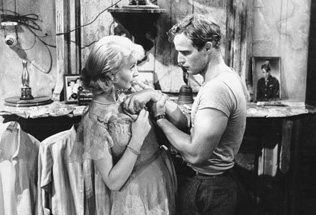AFInity: A Streetcar Named Desire
By Kim Hollis
July 17, 2009
Vivan Leigh was chosen to portray Blanche in the film rather than Jessica Tandy, who had the role in the Broadway production, at the behest of the producers. They felt that Leigh brought more cachet to the role thanks to the widely popular Gone With the Wind. It's fascinating to watch her portrayal of Blanche in light of the fact that she had previously played the Southern belle Scarlet O'Hara, as we once again have that juxtaposition of the old-time, genteel South versus that loss of innocence and prominence that Blanche represents. I don't mean to say that she plays her like Scarlet at all, but it's almost impossible to watch the Blanche performance without referring back to Gone With the Wind. She walks a very fine line, as she has to show us who Blanche is without having a great deal of dialogue to reveal the woman's true nature. It's all in the undertone, and we can sense that Blanche has dark secrets that she wishes to keep hidden, and that madness is simmering somewhere underneath. It's somewhat painful to watch, given the knowledge that Leigh truly did suffer from bipolar disorder and was affected deeply by her work on this film.
Because Blanche must be so dramatic, there are some who might complain that A Streetcar Named Desire is overwrought. It is, but like with Douglas Sirk's films, there's a point to the melodrama, as there is much more bubbling under the surface than meets the eye. In fact, I'm a little surprised that Streetcar was so well received when Sirk's pictures were critically reviled in the same era. Perhaps there was just a presumption that a movie based on a Tennessee Williams play would have deeper, more significant themes.
It's this depiction of an evolving South (and America) that makes A Streetcar Named Desire such an important film historically. It unabashedly takes on issues like abuse, rape, sexuality and madness head on, which is fairly shocking considering it was released in 1951. For anyone who believes that those were simpler and sunnier times, it only takes a couple of hours watching this film to realize that more than half a century later, we aren't that enlightened. It still feels timely more than 50 years after its release, and clearly has a justifiable place on the AFI list. It's not necessarily one of those movies you may want to watch over and over again – it's just too painful – but the questions and ideas it presents are worthy of consideration.
Kim's AFInity Project Big Board
Continued:
1
2
3
4
|
|
|
|




